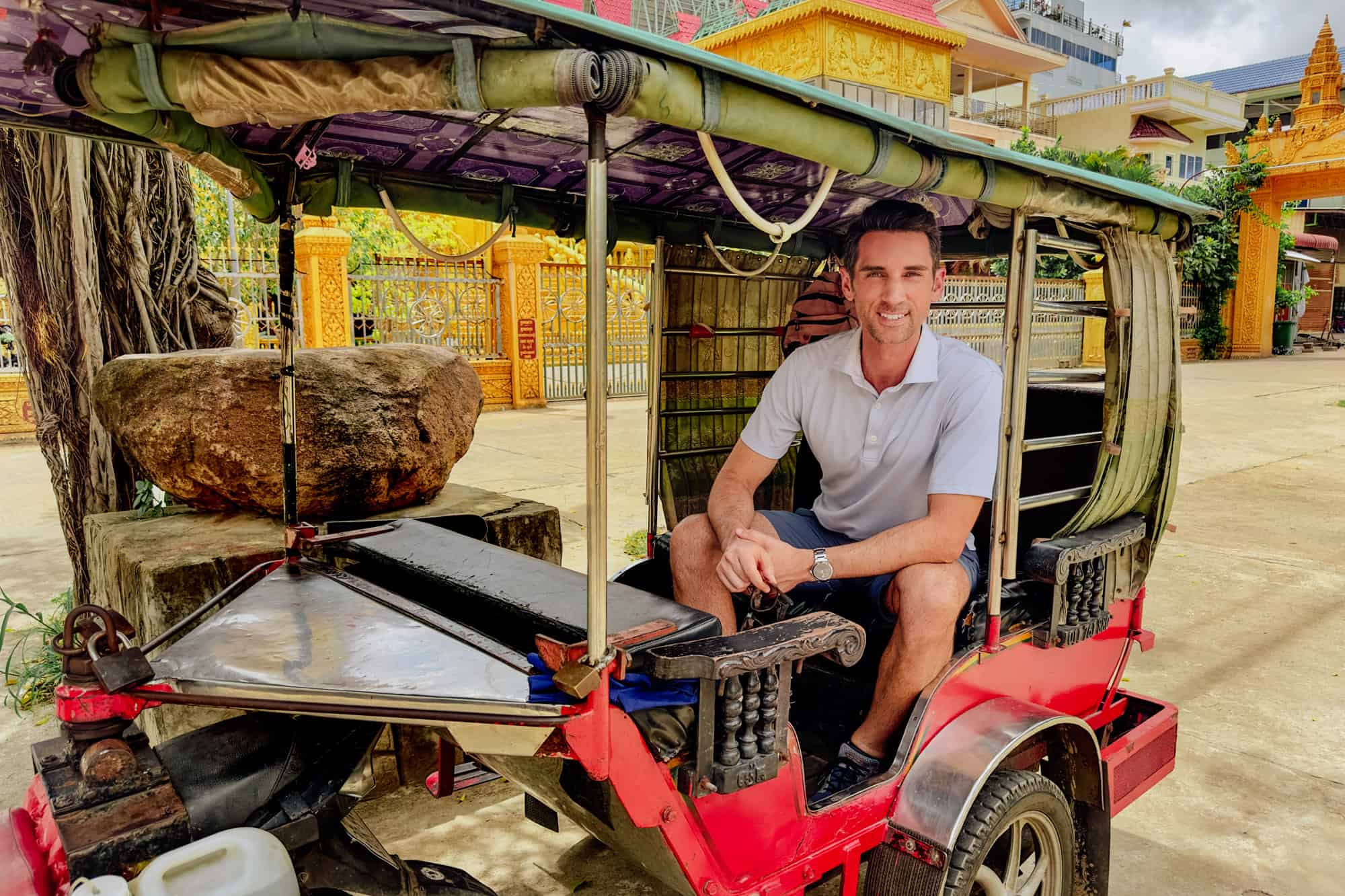The Best Time to Visit Cambodia: Wet Vs. Dry Seasons

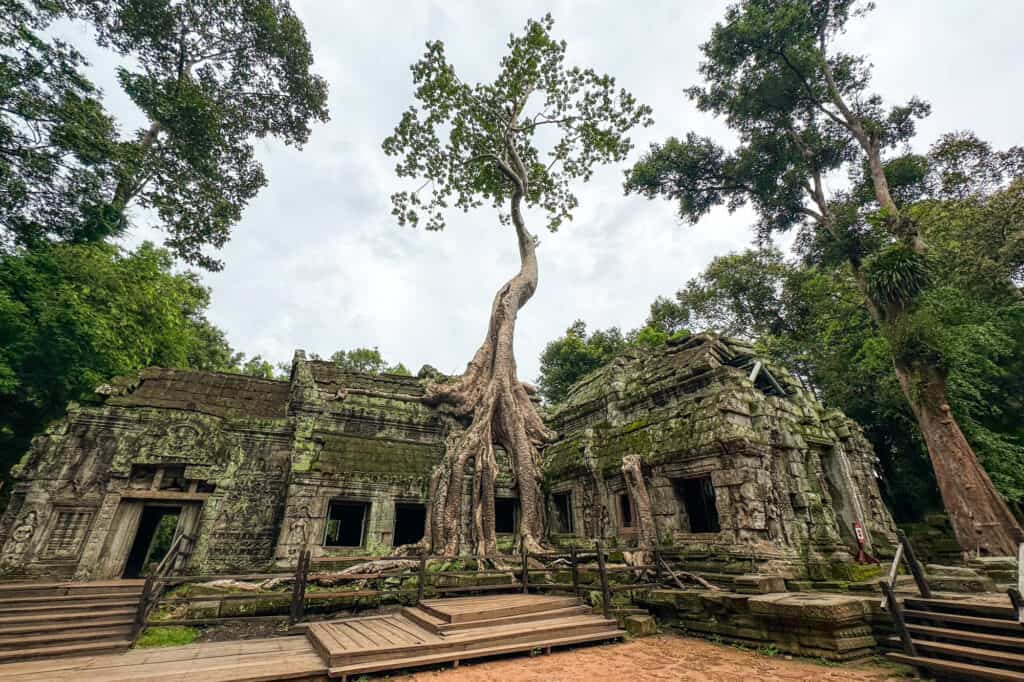
BY JARED DILLINGHAM
Cambodia, located in Southeast Asia, has a tropical climate with distinct wet and dry seasons. The best time to visit Cambodia largely depends on your preferences and what you want to do during your trip.
I’ll go into the weather for each season down below, and do a month-by-month breakdown of the pros and cons.
In general, these are the guidelines:
- ☀️ Best weather: November – February
- 💰 Best prices: June – August
- 👨👩👧👦 Smaller crowds: May – September
There’s a LOT of information down below, so click on the Table of Contents below to skip to the conditions in the month(s) you’re thinking of visiting Cambodia.
The Best Season to Visit Cambodia
Here’s a seasonal breakdown of the weather in Cambodia:
- November to February (Dry Season):
- Winter Weather: This is considered the best time to visit Cambodia as the weather is cool and dry. Daytime temperatures range from 25°C to 30°C (77°F to 86°F).
- Winter Highlights: Ideal for exploring temples like Angkor Wat, and enjoying the beaches in Sihanoukville and nearby islands. The water levels at Tonle Sap Lake are low, making it a good time for boat tours.
2. March to May (Hot Season):
- Spring Weather: Cambodia starts to heat up during these months, with temperatures often exceeding 35°C (95°F) in some areas. It’s still relatively dry in the spring.
- Spring Highlights: Despite the heat, spring is still a popular time to visit. It’s best for early morning temple visits and indoor activities. Consider Cambodia’s coastal areas for a bit of relief from the heat.
3. June to August (Wet Season – Monsoon):
- Summer Weather: These months bring heavy rainfall and high humidity to Cambodia. Expect daily afternoon downpours, especially in July and August.
- Summer Highlights: While it’s the rainy season, you’ll find lower prices at hotels. The landscape is lush and green, and the temples are far less crowded.
4. September to October (Transition Period):
- Fall Weather: Cambodia starts transitioning from the wet season to the dry season during these months. Rainfall decreases gradually.
- Fall Highlights: It can be a good time to visit Cambodia, if you don’t mind occasional rain showers. The Cambodian countryside is at its most vibrant, and the crowds are still small.
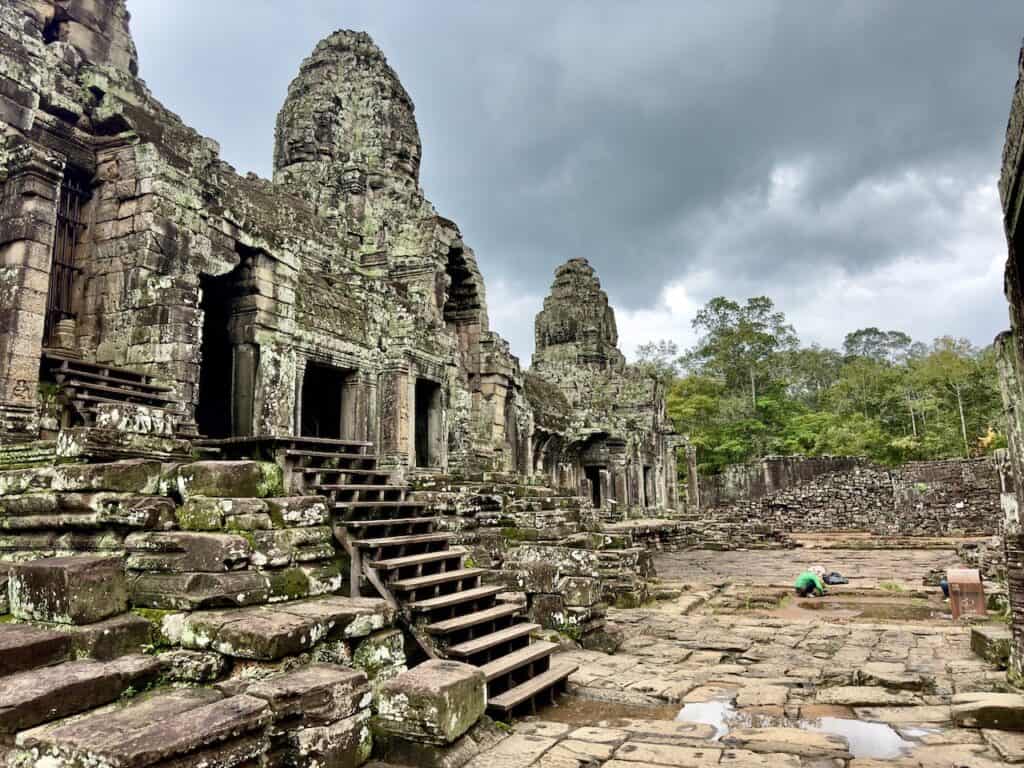
The Best Tours in Cambodia
Regardless of the season, you can enjoy tours of Phnom Penh, the Mekong River, and all of the mysterious and awe-inspiring temples around Siem Reap.
I’d recommend these top tours in Phnom Penh, any time of the year:
🇰🇭 Phnom Penh & Killing Fields Tour
🇰🇭 Click to Book: Silk Island Bike Tour
🇰🇭 Click to Book: Mekong Sunset Cruise
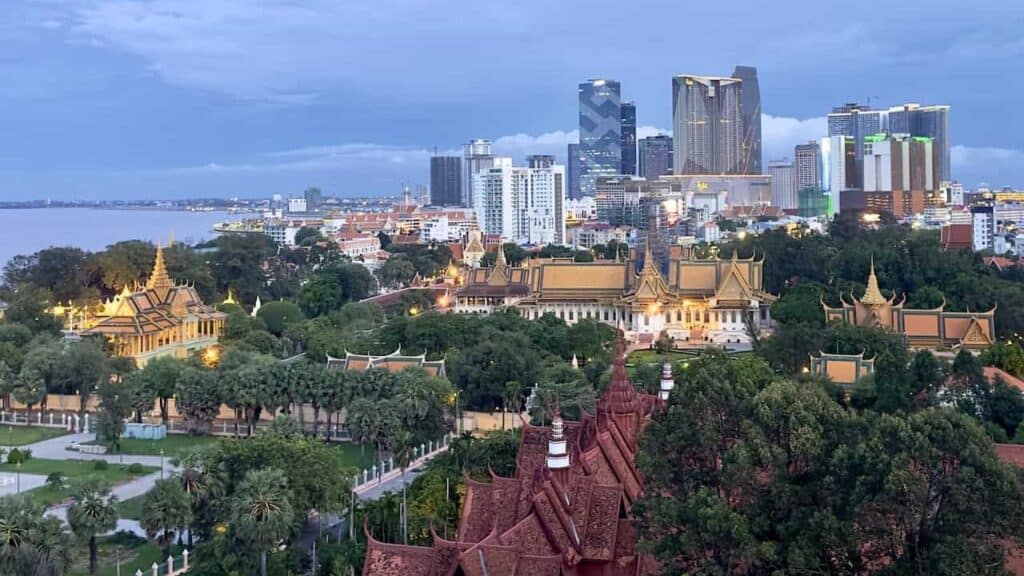
And I’d recommend these tours from Siem Reap:
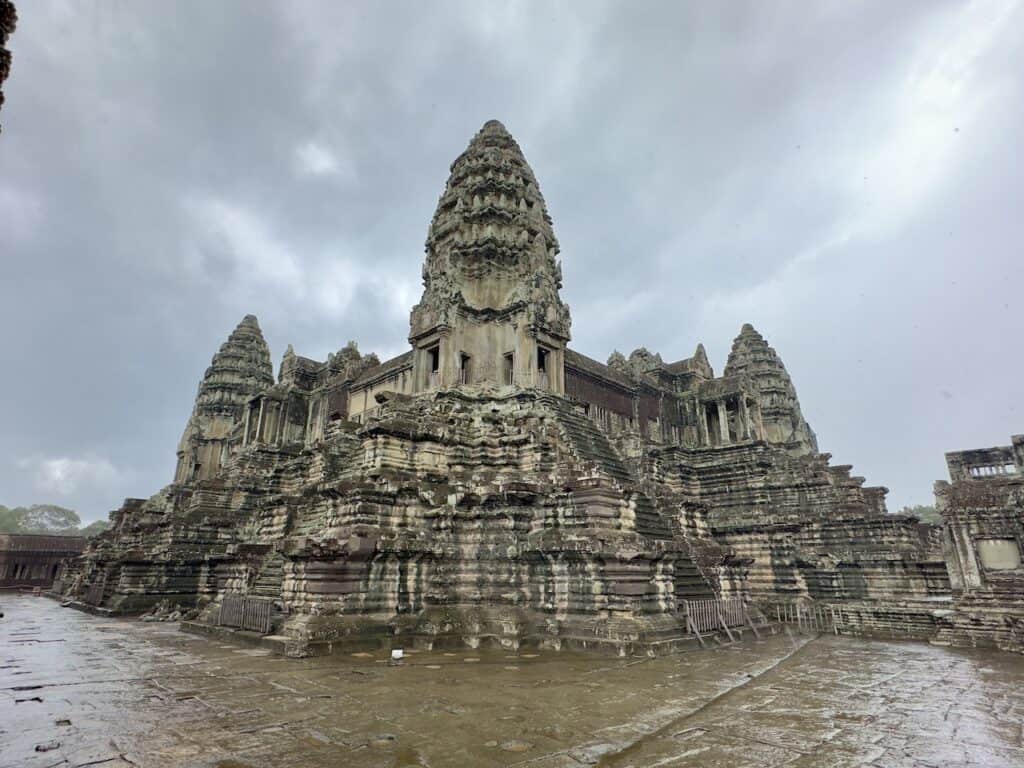
Visit Cambodia in January
January is generally considered to be one of the best times to visit Cambodia, simply due to the nice weather. Just keep in mind that this is the high tourist season, so accommodations and attractions may be busier and more expensive.
Pros of Visiting Cambodia in January:
- Ideal Weather: January is considered one of the best times to visit Cambodia in terms of weather. It falls within the dry season, offering cool and dry conditions with daytime temperatures ranging from 25°C to 30°C (77°F to 86°F).
- Clear Skies: January typically brings clear skies and plenty of sunshine, ensuring great visibility for photography and outdoor experiences.
- Perfect for Temple Exploration: The comfortable weather in January is ideal for exploring the temples of Angkor, including the iconic Angkor Wat. You can spend extended periods exploring these historical sites without the discomfort of extreme heat or rain.
- Festivities: Cambodia celebrates the New Year, and you can expect a festive atmosphere with celebrations, cultural events, and special activities, especially in urban areas like Siem Reap and Phnom Penh.
Cons of Visiting Cambodia in January:
- Peak Tourist Season: January is part of the peak tourist season in Cambodia. Popular destinations like Angkor Wat and coastal areas can get crowded, and accommodations may be more expensive.
- Higher Prices: Due to the high demand from tourists, you may find that prices for accommodations, flights, and tours are relatively higher in January compared to other times of the year.
- Limited Availability: It’s advisable to book your accommodations and tours well in advance, as the most sought-after options can fill up quickly during January.
- Traffic and Crowds: Urban areas like Siem Reap and Phnom Penh can experience heavy traffic and large crowds during the peak tourist season.
- Less Availability of Guides: Due to high demand, there may be limited availability of English-speaking guides for temple tours and other activities.
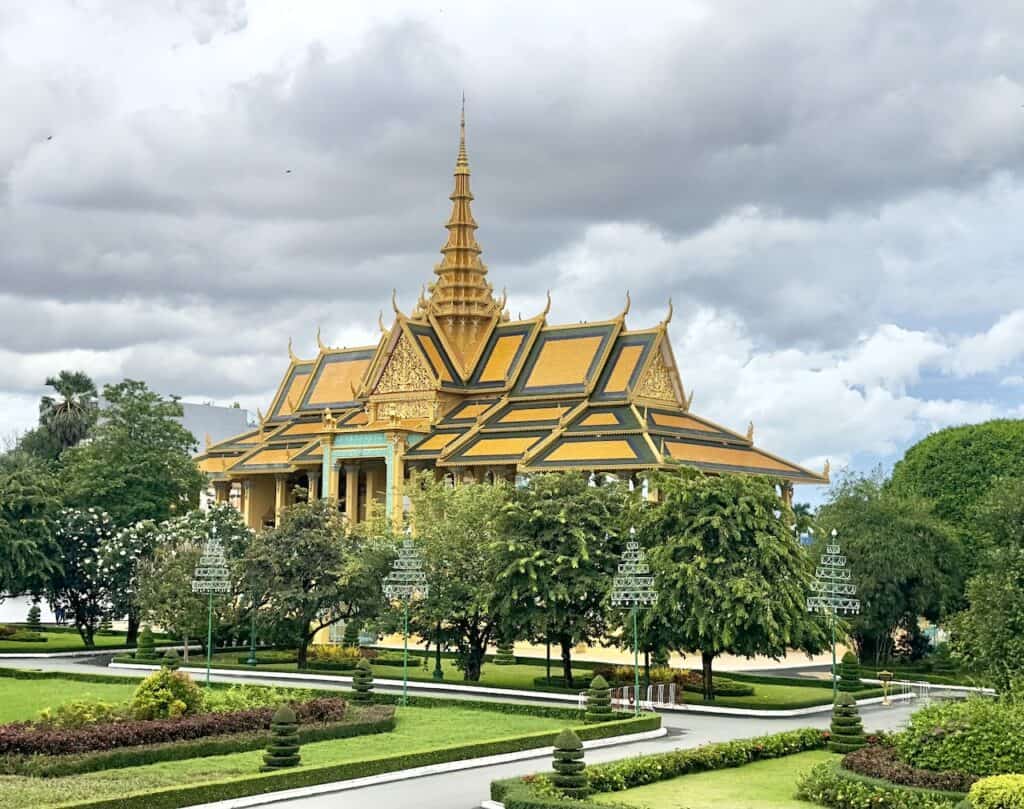
Visit Cambodia in February
Visiting Cambodia in February offers excellent weather and is particularly great for exploring temples, enjoying outdoor activities, and experiencing cultural events. However, keep in mind the potential for higher prices and tourist crowds. If you prefer quieter and more budget-friendly travel, you might consider visiting during the shoulder season, which is right before or after the peak tourist months.
Pros of Visiting Cambodia in February:
- Excellent Weather: February falls within the dry season in Cambodia, with daytime temperatures ranging from 25°C to 30°C (77°F to 86°F). This makes it an ideal time for outdoor activities and sightseeing.
- Ideal for Temple Exploration: The dry and cool weather is perfect for exploring the temples of Angkor, including the iconic Angkor Wat, without the discomfort of extreme heat. You can spend more time exploring the intricate details of these historic sites.
- Less Crowded Than December and January: While February is a popular month for tourists, it tends to be less crowded than December and January, which are peak tourist months.
Cons of Visiting Cambodia in February:
- Peak Tourist Season: While it’s less crowded than December and January, February is still considered part of the peak tourist season. Popular destinations like Siem Reap (home to Angkor Wat) and Phnom Penh can get crowded, and accommodations may be more expensive.
- Higher Prices: Due to the high demand from tourists, you may find that prices for accommodations, flights, and tours are relatively higher in February compared to other times of the year.
- Limited Availability: It’s advisable to book your accommodations and tours well in advance, as the most sought-after options can fill up quickly during February.
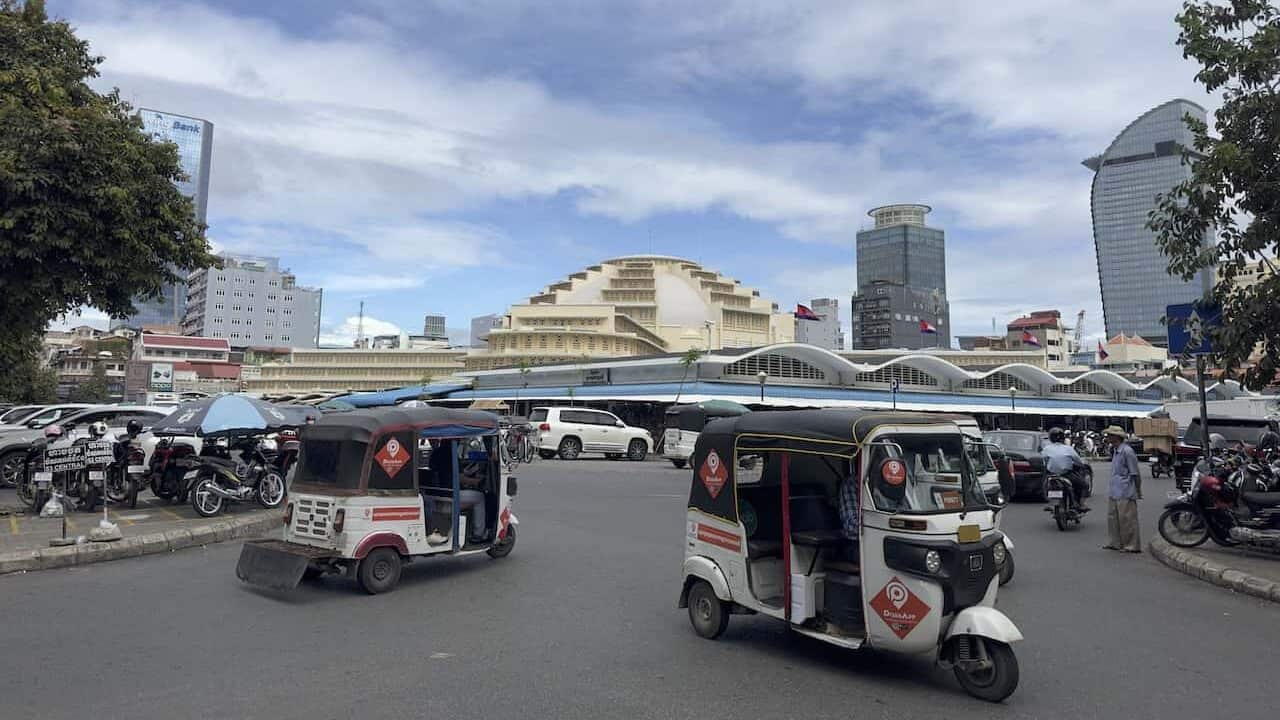
Visit Cambodia in March
Visiting Cambodia in March has its own set of advantages and disadvantages. Here’s a breakdown of the pros and cons:
Pros of Visiting Cambodia in March:
- Warm Weather: March in Cambodia is warm, with daytime temperatures typically ranging from 28°C to 35°C (82°F to 95°F). If you enjoy hot weather and sunny days, this can be a pro for you.
- Dry Conditions: March is still part of the dry season, which means you can expect minimal rainfall and dry conditions.
- Ideal for Beaches: If you plan to visit Cambodia’s coastal areas, such as Sihanoukville or nearby islands like Koh Rong, March offers ideal beach weather with plenty of sunshine and warm waters.
- Temple Exploration: The dry and warm weather is suitable for exploring the temples of Angkor, including Angkor Wat. You can spend extended periods exploring these historical sites without being bothered by rain.
- Cultural Festivals: Depending on the lunar calendar, the Khmer New Year often falls in April, but preparations and celebrations may start in March. This can provide a unique cultural experience.
Cons of Visiting Cambodia in March:
- Hot and Humid: While some travelers enjoy the warm weather, others may find the temperatures in Cambodia during March uncomfortably hot, especially if you’re not accustomed to high heat and humidity.
- Crowds: March is still a relatively busy tourist month, particularly in popular destinations like Siem Reap (Angkor Wat) and Phnom Penh. You may encounter larger crowds at popular tourist sites.
- Higher Prices: Due to the continued tourist demand, you might find that accommodations, flights, and tours are relatively more expensive in March compared to the shoulder or low seasons.
- Limited Availability: It’s a good idea to book your accommodations and tours in advance, as the most sought-after options can fill up quickly during this peak tourist period.
- Unpredictable Fire Season: In some areas of Cambodia, particularly in the countryside, March can be associated with agricultural burning and haze. This can impact air quality and visibility, although the severity varies from year to year.
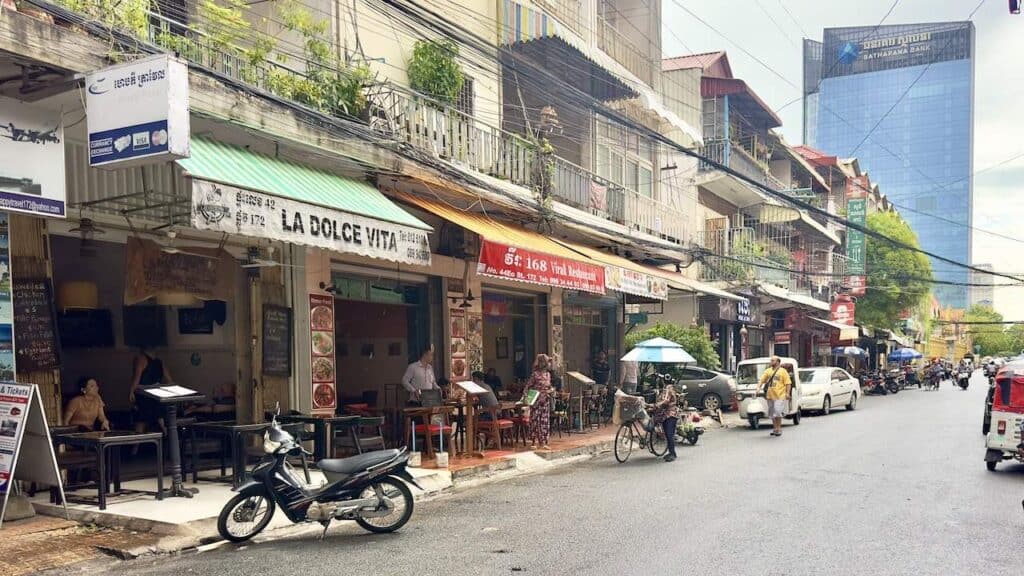
Visit Cambodia in April
Visiting Cambodia in April can be rewarding for those interested in experiencing Khmer New Year festivities, warm weather, and beach vacations. However, the extreme heat can be challenging for some travelers. If you can tolerate the heat and plan your activities accordingly, April can offer a unique cultural experience in Cambodia.
Pros of Visiting Cambodia in April:
- Cultural Festivals: April marks the beginning of the Khmer New Year, which is one of the most important festivals in Cambodia. The celebrations include traditional ceremonies, water splashing, and various cultural activities.
- Warm and Sunny Weather: April is characterized by warm and sunny weather, with daytime temperatures often ranging from 30°C to 35°C (86°F to 95°F). If you enjoy hot and tropical weather, this can be a pro.
- Ideal for Beaches: If you plan to visit Cambodia’s coastal areas, such as Sihanoukville, April offers excellent beach weather with plenty of sunshine and warm waters.
- Longer Daylight Hours: April has longer daylight hours, allowing you to make the most of your outdoor activities and sightseeing.
Cons of Visiting Cambodia in April:
- Extreme Heat: April is the hottest month in Cambodia, and temperatures can soar above 35°C (95°F) in many parts of the country. The high heat and humidity can be challenging for some travelers and may limit outdoor activities during the middle of the day.
- Dry Conditions: While April is part of the dry season, it’s also the end of the dry season. As a result, the landscape may become parched, and dust can be an issue, particularly in rural areas.
- Crowds: Due to the Khmer New Year celebrations and school holidays, Cambodia can be crowded with local tourists during this period. Popular tourist destinations, like Siem Reap (Angkor Wat), may have larger crowds.
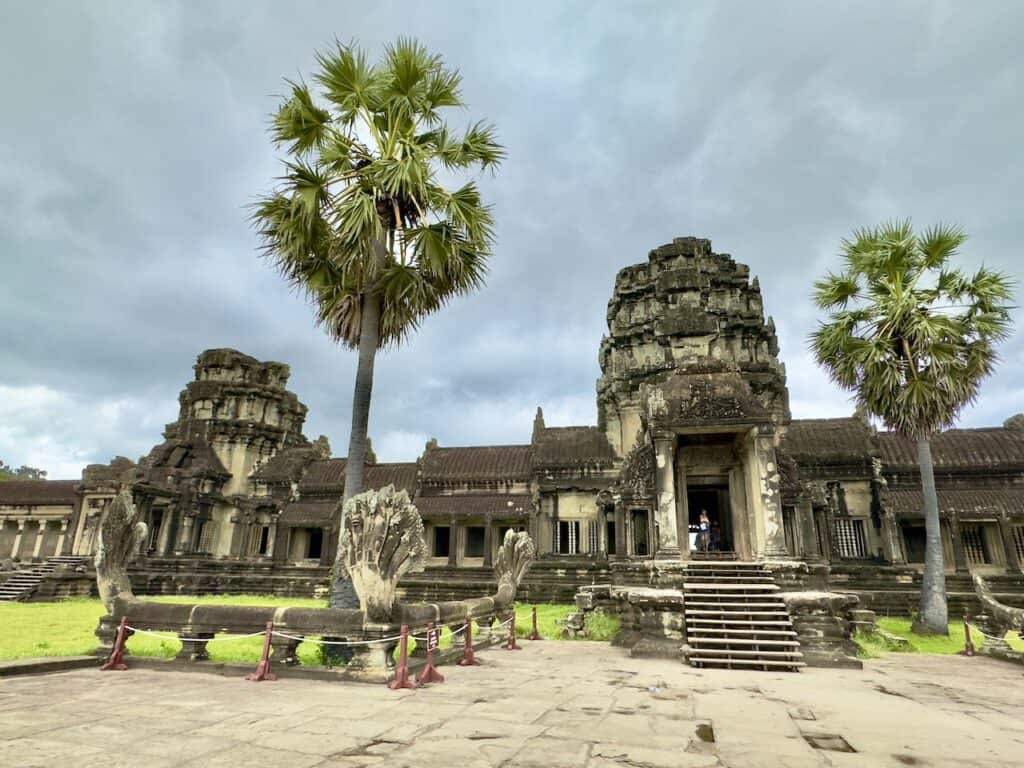
Visit Cambodia in May
Visiting Cambodia in May can be a budget-friendly option with fewer tourists, lush landscapes, and unique experiences. However, the rainy season can be a significant drawback, leading to disruptions in outdoor activities and humidity. If you don’t mind occasional rain and are looking for a quieter and more affordable travel experience, May might be a suitable time to visit.
Pros of Visiting Cambodia in May:
- Low Tourist Crowds: May is the beginning of the rainy season, and it’s considered the start of the shoulder or low tourist season. This means fewer crowds at popular tourist destinations like Angkor Wat, and lower prices for accommodations and tours.
- Lush Green Landscapes: The arrival of the rainy season means the Cambodian countryside is lush and green.
- Discounted Prices: Due to the lower tourist demand, you can often find discounted prices on accommodations and tour packages in May. This can make your trip more budget-friendly.
Cons of Visiting Cambodia in May:
- Rainy Season Begins: May marks the beginning of the wet season in Cambodia, and rainfall becomes more frequent. Expect daily afternoon downpours, which can sometimes be heavy and last for a few hours. This can disrupt outdoor activities and sightseeing.
- High Humidity: The rainy season brings higher humidity levels, making it feel muggy and uncomfortable, especially when it’s not raining.
- Mosquitoes and Insects: The wet season can bring an increase in mosquitoes and other insects, so it’s important to take precautions against insect bites.
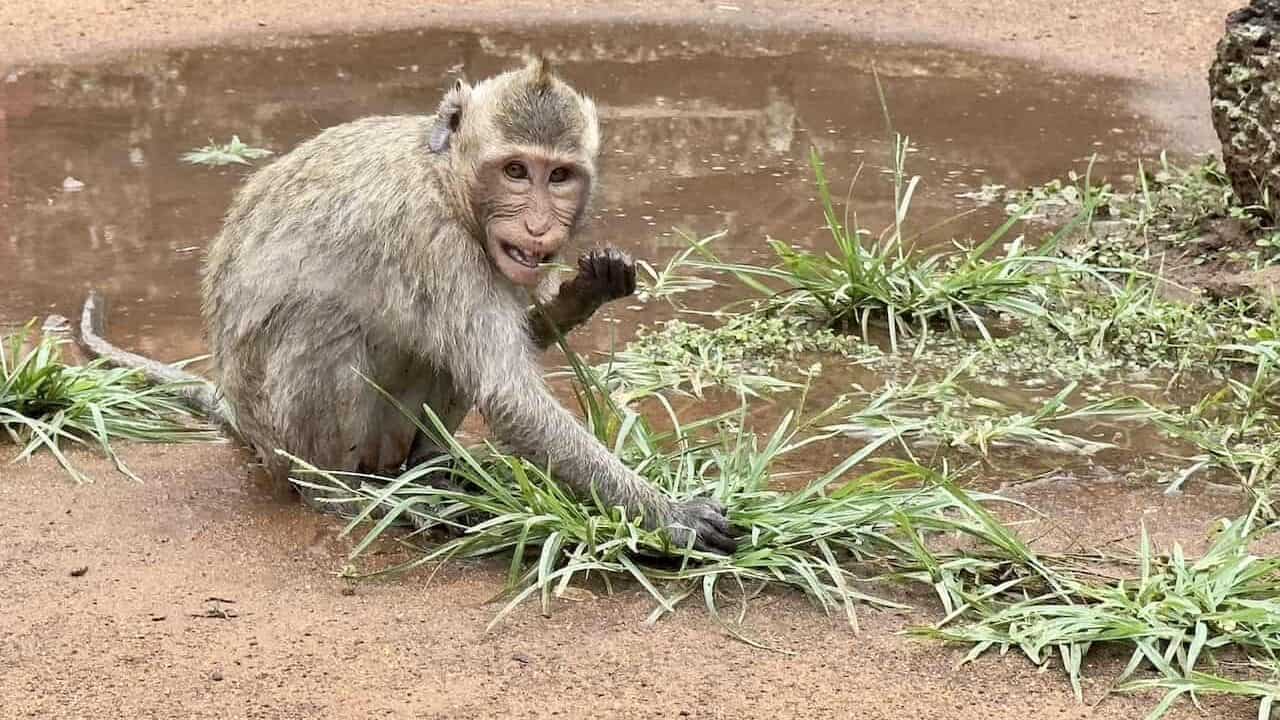
Visit Cambodia in June
Visiting Cambodia in June can offer budget-friendly travel with fewer tourists and lush landscapes. However, the rainy season can be a significant drawback, leading to disruptions in outdoor activities, transportation delays, and discomfort due to humidity. If you’re willing to embrace the rainy season experience and don’t mind occasional rain, June can provide a unique and quieter perspective of Cambodia.
Pros of Visiting Cambodia in June:
- Low Tourist Crowds: June is part of the rainy season, which is considered the low tourist season in Cambodia. This means fewer tourists at popular attractions like Angkor Wat and reduced prices for accommodations and tours.
- Lush Landscapes: The rainy season transforms Cambodia into a lush and vibrant green landscape. If you appreciate lush, tropical scenery, this can be a beautiful time to visit.
- Budget-Friendly Travel: Due to reduced demand, you can often find lower prices for accommodations and tour packages in June, making it a more budget-friendly time to visit.
Cons of Visiting Cambodia in June:
- Rainy Season: June falls within the rainy season in Cambodia, and you can expect daily afternoon downpours, which can be heavy and last for a few hours. This can disrupt outdoor activities, sightseeing, and transportation.
- High Humidity: The rainy season is associated with higher humidity levels, which can make the weather feel muggy and uncomfortable, especially when it’s not raining.
- Mosquitoes and Insects: The wet season often brings an increase in mosquitoes and other insects, so you should take precautions against insect bites.
- Limited Beach Time: Coastal areas like Sihanoukville may not be ideal for beach activities due to the unpredictable weather during the rainy season.
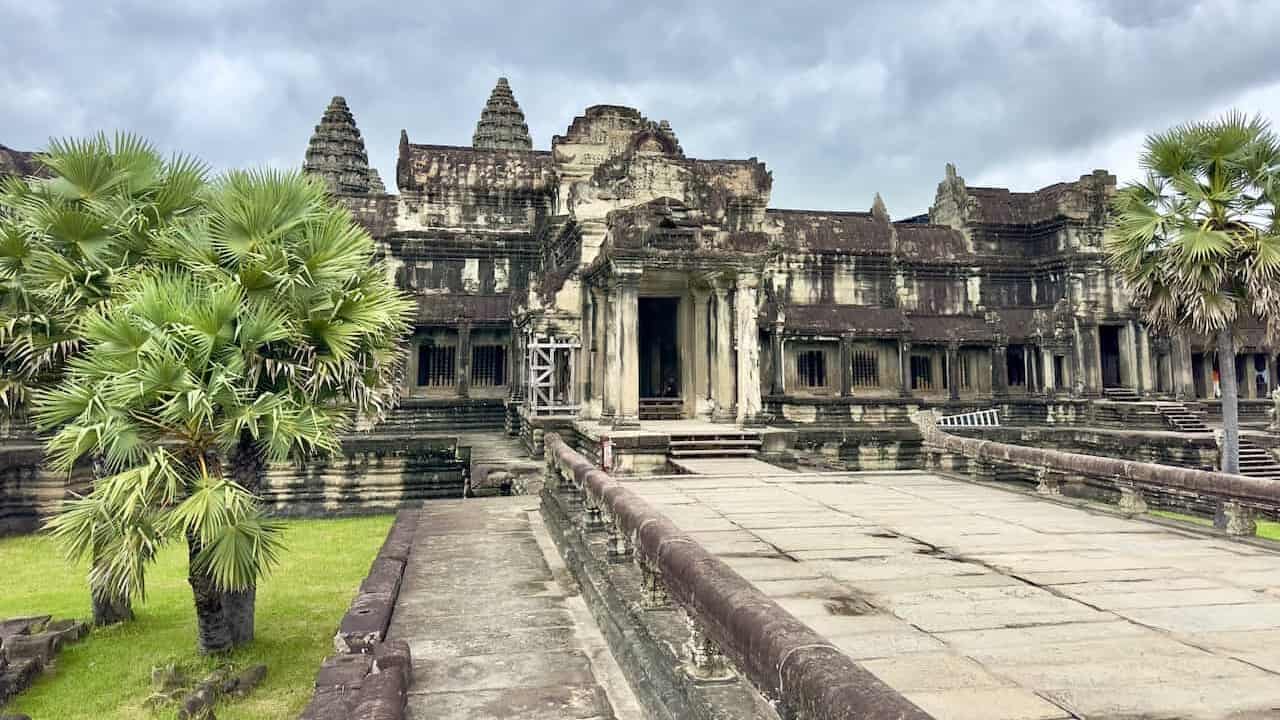
Visit Cambodia in July
Visiting Cambodia in July can offer budget-friendly travel with fewer tourists and lush landscapes. However, the rainy season can be a significant drawback, leading to disruptions in outdoor activities, transportation delays, and discomfort due to humidity.
Pros of Visiting Cambodia in July:
- Small Crowds: July is part of the rainy season, which is considered the low tourist season in Cambodia. This means fewer tourists at popular attractions like Angkor Wat, allowing for a quieter and more peaceful experience.
- Lush Landscapes: The rainy season transforms Cambodia into a lush and vibrant green landscape. If you appreciate lush, tropical scenery, this can be a beautiful time to visit.
- Budget-Friendly Travel: Due to reduced demand, you can often find lower prices for accommodations and tour packages in July, making it a more budget-friendly time to visit.
Cons of Visiting Cambodia in July:
- Rainy Season: July falls within the rainy season in Cambodia, and you can expect daily afternoon downpours, which can be heavy and last for a few hours. This can disrupt outdoor activities, sightseeing, and transportation.
- High Humidity: The rainy season is associated with higher humidity levels, which can make the weather feel muggy and uncomfortable, especially when it’s not raining.
- Limited Beach Time: Coastal areas like Sihanoukville may not be ideal for beach activities due to the unpredictable weather during the rainy season.
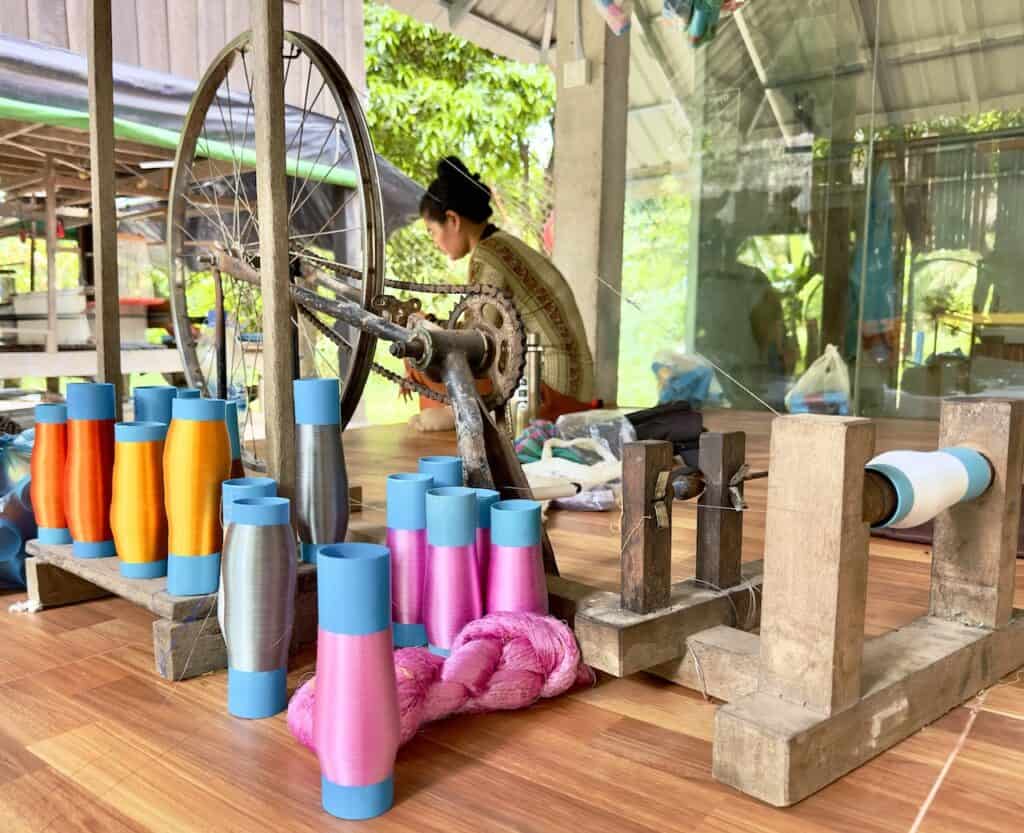
Visit Cambodia in August
Visiting Cambodia in August can offer budget-friendly travel with fewer tourists and lush landscapes. If you’re willing to embrace the rainy season experience and don’t mind the humidity, August can provide a unique and quieter perspective of Cambodia.
Pros of Visiting Cambodia in August:
- Low Tourist Crowds: August is part of the rainy season, which is considered the low tourist season in Cambodia. This means fewer tourists at popular attractions like Angkor Wat, allowing for a quieter and more peaceful experience.
- Lush Landscapes: The rainy season transforms Cambodia into a lush and vibrant green landscape. If you appreciate lush, tropical scenery, this can be a beautiful time to visit.
- Budget-Friendly Travel: Due to reduced demand, you can often find lower prices for accommodations and tour packages in August, making it a more budget-friendly time to visit.
Cons of Visiting Cambodia in August:
- Rainy Season: August falls within the rainy season in Cambodia, and you can expect daily afternoon downpours, which can be heavy and last for a few hours. This can disrupt outdoor activities, sightseeing, and transportation.
- High Humidity: The rainy season is associated with higher humidity levels, which can make the weather feel muggy and uncomfortable, especially when it’s not raining.
- Mosquitoes and Insects: The wet season often brings an increase in mosquitoes and other insects, so you should take precautions against insect bites.
- Limited Beach Time: Coastal areas like Sihanoukville may not be ideal for beach activities due to the unpredictable weather during the rainy season.
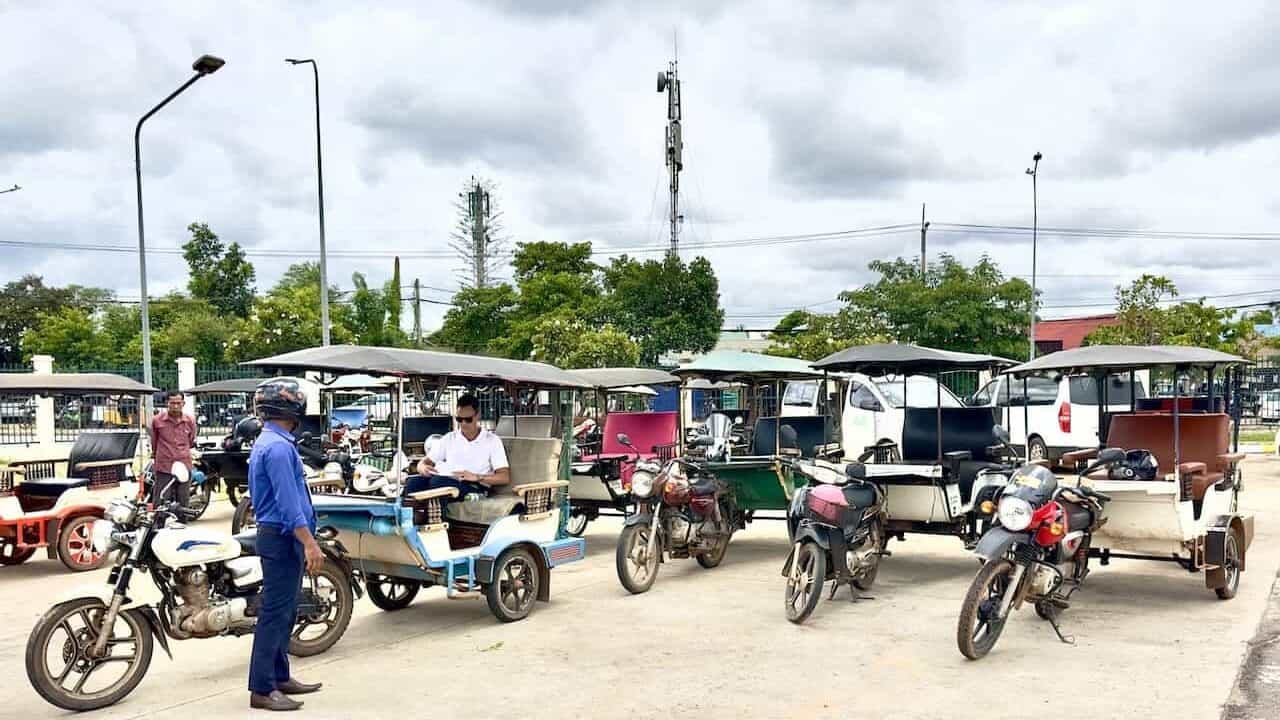
Visit Cambodia in September
Visiting Cambodia in September can offer budget-friendly travel with fewer tourists and lush landscapes. However, afternoon showers persist and the humidity lingers in September.
Pros of Visiting Cambodia in September:
- Few Tourists: September is part of the rainy season in Cambodia, which means lower tourist crowds compared to the peak season. This can provide a quieter and more peaceful travel experience.
- Lush Green Landscapes: The rainy season transforms Cambodia into a lush and vibrant green landscape. If you appreciate lush, tropical scenery, this can be a beautiful time to visit.
- Budget-Friendly Travel: Due to reduced demand, you can often find lower prices for accommodations and tour packages in September, making it a more budget-friendly time to visit.
Cons of Visiting Cambodia in September:
- Rainy Season: September falls within the rainy season in Cambodia, and you can expect daily afternoon downpours, which can be heavy and last for a few hours. This can disrupt outdoor activities, sightseeing, and transportation.
- High Humidity: The rainy season is associated with higher humidity levels, which can make the weather feel muggy and uncomfortable, especially when it’s not raining.
- Limited Beach Time: Coastal areas like Sihanoukville may not be ideal for beach activities due to the unpredictable weather during the rainy season.
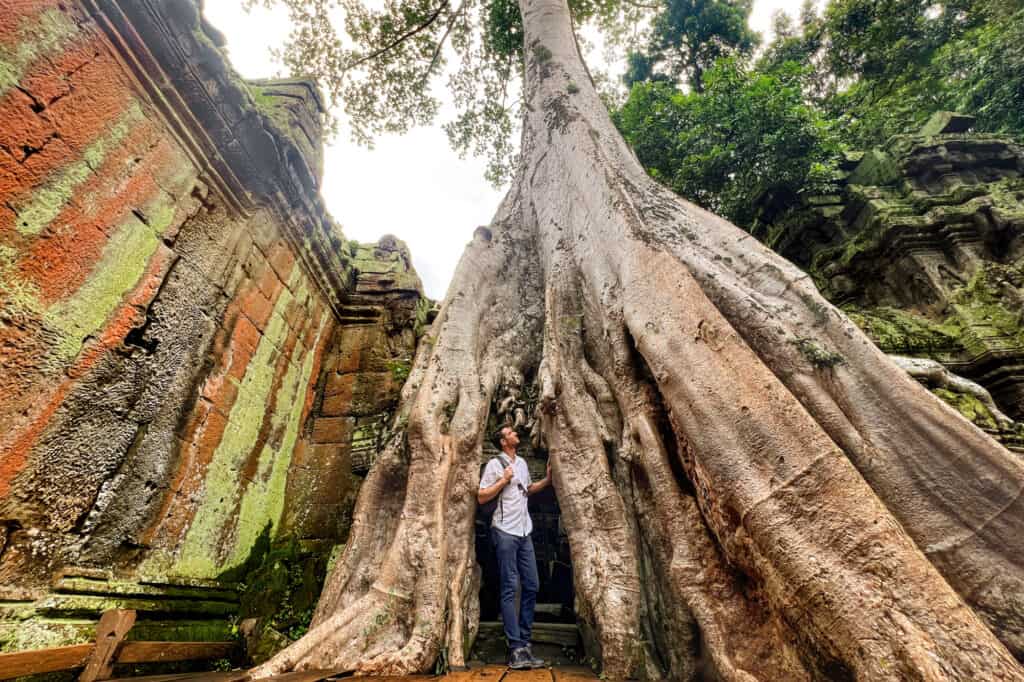
Visit Cambodia in October
October is a good option for a visit to Cambodia, but you should be prepared for occasional rain and some lingering humidity, especially early in the month. If you prefer fewer crowds and are willing to adapt to the unpredictable showers, October has its benefits.
Pros of Visiting Cambodia in October:
- Smaller Crowds: October is considered the shoulder season, falling between the rainy season and the dry season. Tourist crowds tend to be smaller compared to the peak season months, providing a more peaceful travel experience.
- Lush Landscapes: The end of the rainy season means Cambodia’s countryside is at its most vibrant and lush. If you appreciate lush, tropical scenery, October can be a beautiful time to visit.
- Budget-Friendly Travel: Due to reduced demand, you can often find lower prices for accommodations and tour packages in October compared to the peak tourist months.
- Comfortable Weather: October marks the transition from the rainy season to the dry season. While there may still be occasional rain, the weather becomes more comfortable, with decreasing humidity and cooler temperatures.
Cons of Visiting Cambodia in October:
- Rainfall: While October is transitioning to the dry season, there can still be occasional rain, especially early in the month. This can disrupt outdoor activities and sightseeing.
- Humidity: While humidity levels are decreasing, it can still feel somewhat humid in October, especially in the early part of the month.
- Unpredictable Weather: The weather can be somewhat unpredictable in October, with a mix of sunny days and occasional rain. This isn’t really a “con,” but something to keep in mind since it might impact outdoor activities. You can usually just expect some afternoon showers.
- Beach Conditions: Coastal areas like Sihanoukville may not be ideal for beach activities, as the water can still be affected by the earlier rainy season.
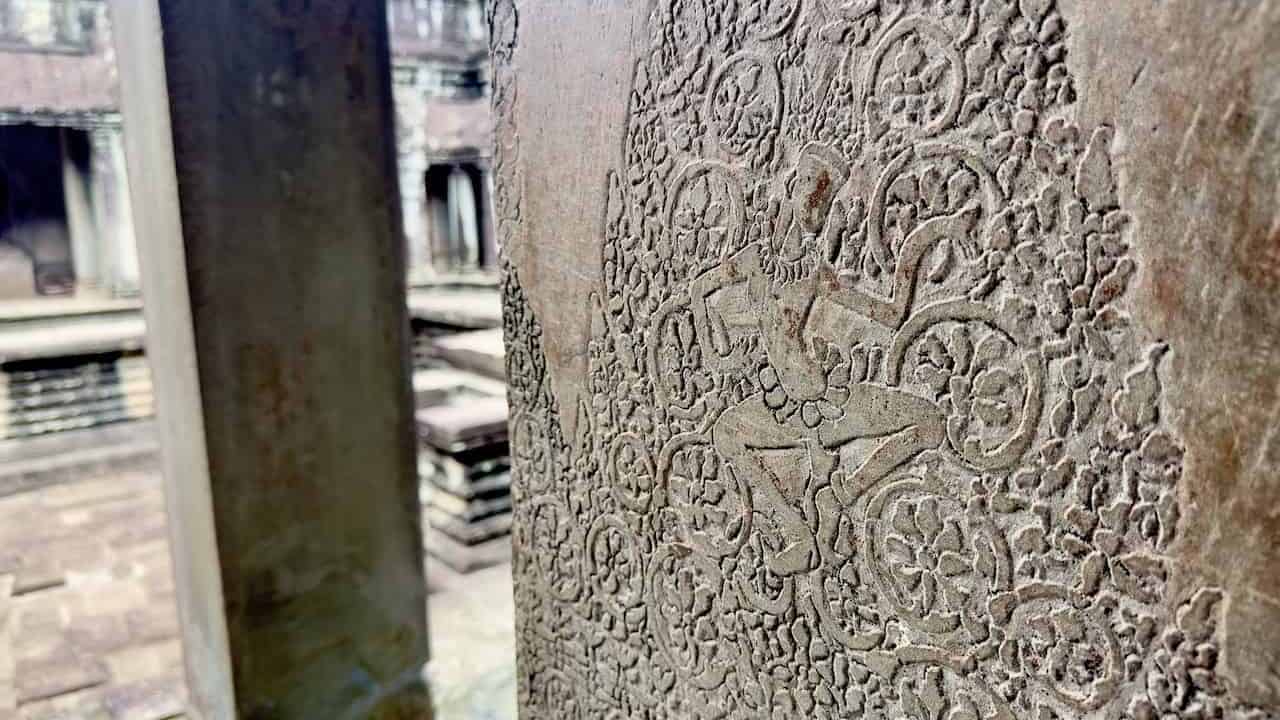
Visit Cambodia in November
Cambodia in November offers excellent weather, making it one of the best times to explore the country comfortably. It’s a great time for outdoor activities, cultural events, and experiencing the beauty of Cambodia’s historic sites. Just be prepared for higher prices and larger tourist crowds.
Pros of Visiting Cambodia in November:
- Ideal Weather: November marks the beginning of the dry season in Cambodia, and the weather is typically excellent. You can expect pleasant temperatures with daytime highs ranging from 77°F to 86°F, lower humidity, and plenty of sunshine.
- Great for Outdoor Activities: The comfortable weather in November is perfect for exploring outdoor attractions, such as the temples of Angkor, without the discomfort of extreme heat or heavy rain.
- Clear Skies: November typically brings clear skies and good visibility, making it an ideal time for photography and outdoor experiences.
- Lower Rainfall: While November is still transitioning from the rainy season, the amount of rainfall decreases significantly compared to the previous months.
- Festivals and Cultural Events: Depending on the lunar calendar, the Water Festival (Bon Om Touk) often takes place in November. This annual festival features boat races, illuminated processions, and various cultural activities.
- Moderate Tourist Crowds: While November is a popular time to visit Cambodia, especially Angkor Wat, tourist crowds are generally lower compared to the peak months of December and January.
Cons of Visiting Cambodia in November:
- Higher Prices: November falls within the peak tourist season, so prices for accommodations, flights, and tours may be relatively higher compared to the shoulder or low seasons.
- Popular Destinations Can Get Crowded: While it’s less crowded than December and January, November can still see moderate crowds, particularly at popular tourist destinations like Siem Reap (Angkor Wat).
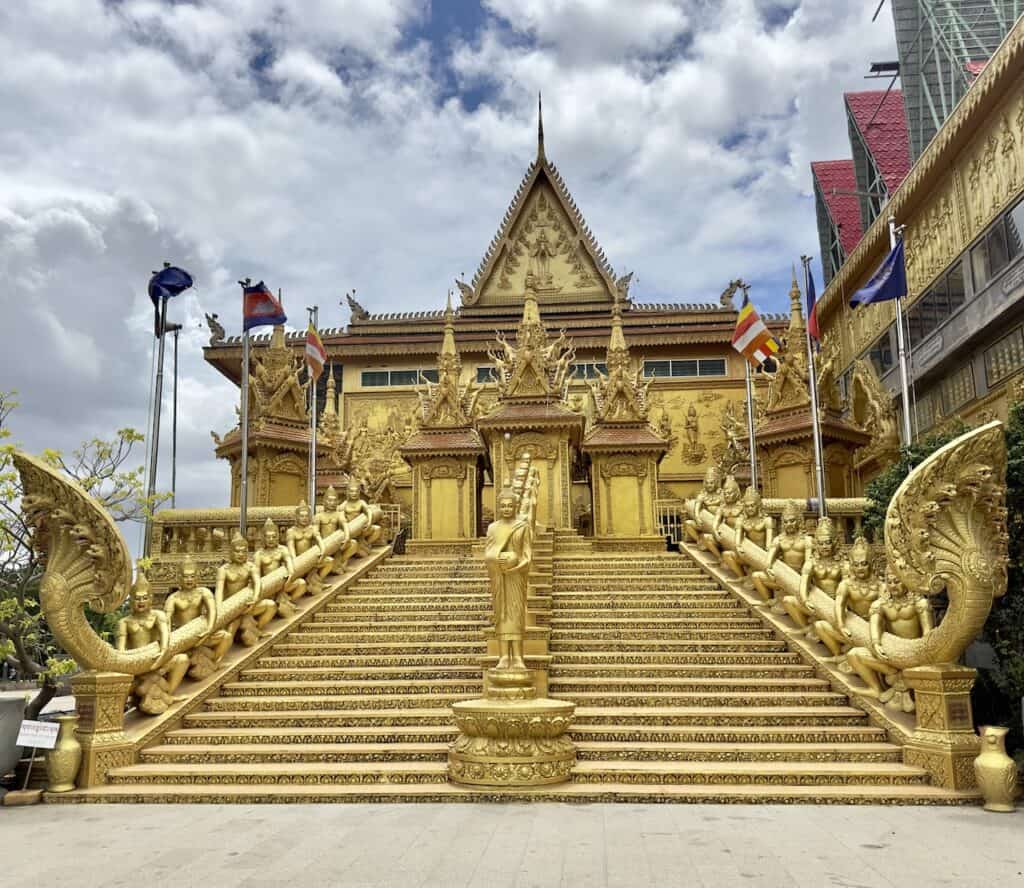
Visit Cambodia in December
December’s weather is usually great, making it a comfortable time for outdoor adventures and temple exploration. Just be prepared for larger crowds and higher prices, especially around Christmas and New Year’s.
Pros of Visiting Cambodia in December:
- Ideal Weather: December is considered one of the best times to visit Cambodia in terms of weather. It offers cool and dry conditions, with daytime temperatures ranging from 77°F to 86°F, making it comfortable for outdoor activities and sightseeing.
- Festive Atmosphere: Cambodia celebrates the Christmas and New Year holidays, and you can expect a festive atmosphere with decorations, special events, and cultural celebrations, especially in urban areas like Phnom Penh and Siem Reap.
- Great for Temple Exploration: The comfortable weather in December is perfect for exploring the temples of Angkor, including Angkor Wat. You can spend extended periods exploring these historical sites without the discomfort of extreme heat or rain.
- Low Humidity: Unlike the hot and humid months of the wet season, December offers lower humidity levels, ensuring a more comfortable and enjoyable travel experience.
Cons of Visiting Cambodia in December:
- Peak Tourist Season: December is part of the peak tourist season in Cambodia, especially around Christmas and New Year’s. Popular destinations like Angkor Wat and coastal areas can get crowded, and accommodations may be more expensive.
- Higher Prices: Due to the high demand from tourists, you may find that prices for accommodations, flights, and tours are relatively higher in December compared to other times of the year.
- Limited Availability: It’s advisable to book your accommodations and tours well in advance, as the most sought-after options can fill up quickly during December.
- Traffic and Crowds: Urban areas like Siem Reap and Phnom Penh can experience heavy traffic and large crowds during the peak tourist season.
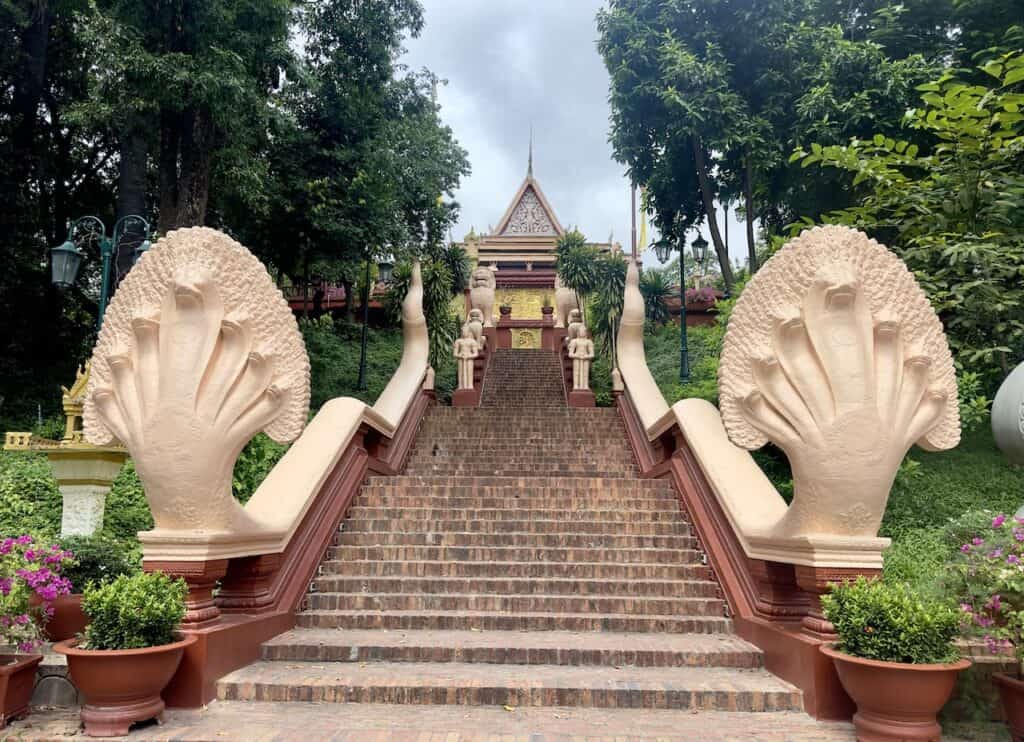
FAQs on a Trip to Cambodia
Let’s answer a few final frequently asked questions about traveling to Cambodia.
What currency is accepted in Cambodia?
The US Dollar is widely accepted and appreciated in Cambodia, whether you’re tipping, paying a tuk-tuk driver, or hiring a tour guide.
Bring small denominations (lots of $1s, $5s, and $10s).
Are tuk-tuks a good way to get around Cambodia?
Yes, tuk-tuks are a safe and efficient way to get around the cities of Cambodia. From the moment you walk out of the airport, you’ll see tuk-tuk drivers offering to give you a lift.
Negotiate your price ahead of time. A typical ride from the airport to the palace area hotels will be $10 USD.
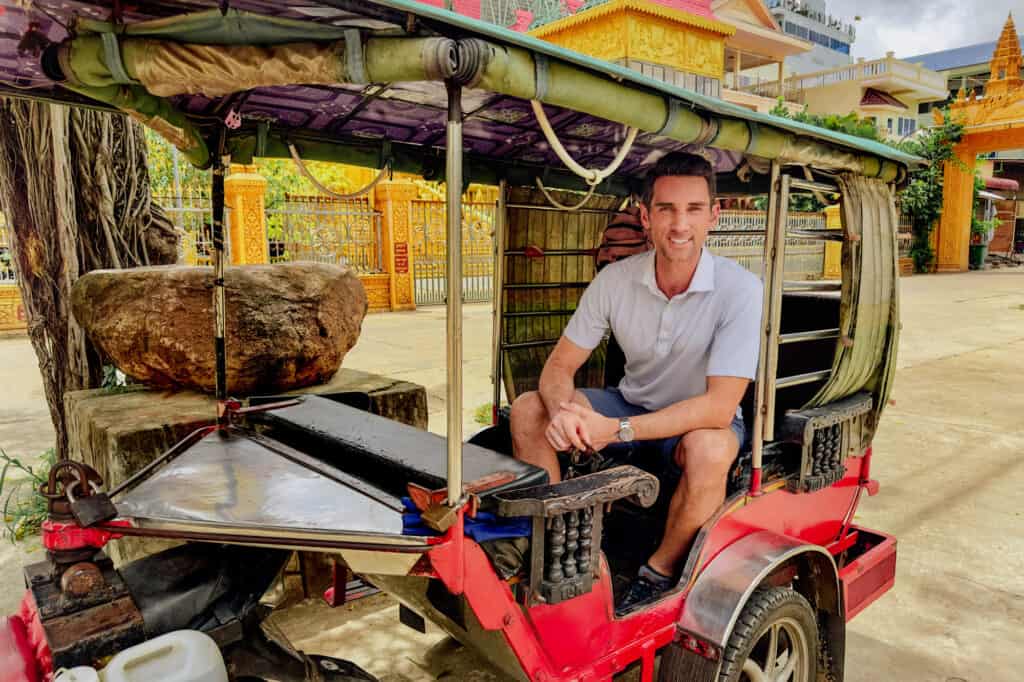
How many days do you need in Phnom Penh?
You can see most of the main sites in Phnom Penh in a single day. From the Royal Palace to the Central Market to the Wat Phnom Temple, you can pack a lot into 24 hours in the city before moving on.
How many days do you need at Siem Reap?
I’d say you need a few days in Siem Reap to truly see all of the temples and other sites around the city.
Is a Mekong River cruise from Cambodia worth it?
A Mekong River cruise is an unforgettable trip through Cambodia and Vietnam. While Siem Reap isn’t on the Mekong, Heritage Line and other companies allow their guests to fly there, spend a few days, and then join the riverboat a few hours away. Other stops include Phnom Penh and a variety of local villages on the Mekong as you make your way down to Ho Chi Minh City, Vietnam.
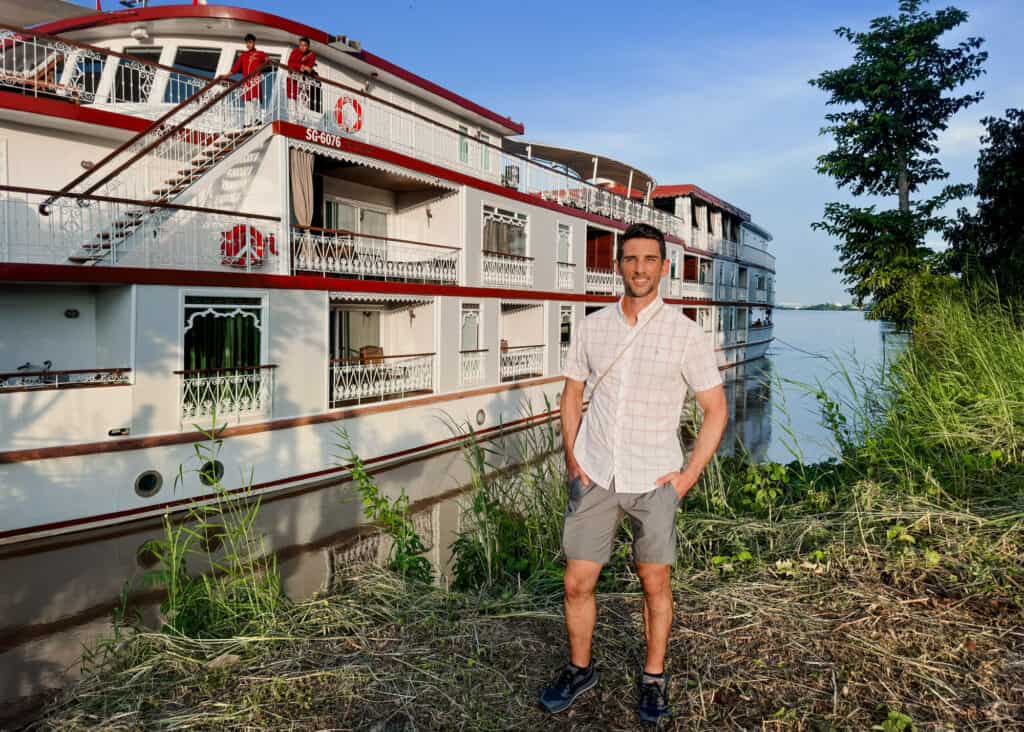
Wrap: The Best Time to Visit Cambodia
In summary, the best time to visit Cambodia for most travelers is during the dry season, from November to February, when the weather is pleasant and ideal for exploring temples and outdoor activities. However, if you prefer fewer crowds and don’t mind occasional rain, the transition period (September to October) can also be a good choice. Be prepared for the heat if you visit during the hot season (March to May), and consider the wet season (June to August) if you want to experience Cambodia in a different light with lush landscapes and lower prices.
Check out our other posts on Cambodia and Southeast Asia!
